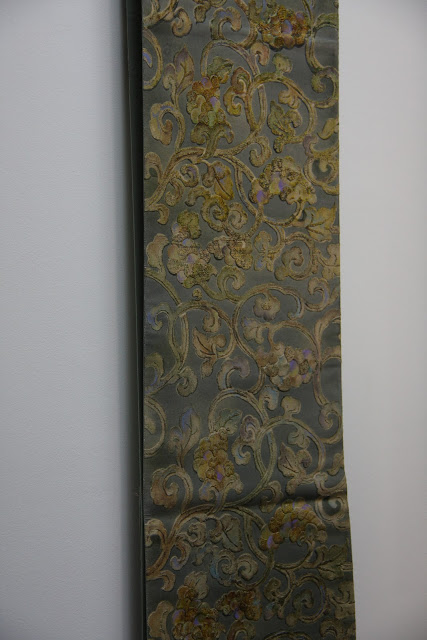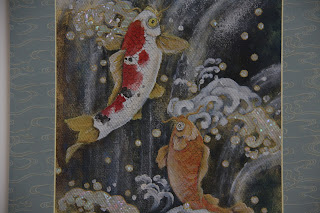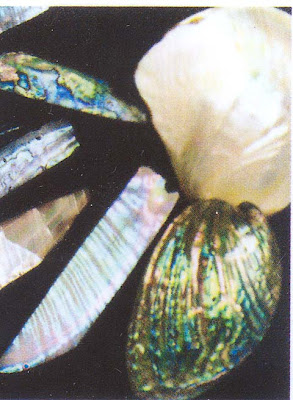◇◇◇◇◇◇◇◇◇◇◇◇◇◇◇◇◇◇◇◇◇◇◇◇◇◇◇◇◇◇◇◇◇
No.1
KAMO-NO-KURABEUMA
Japanese Traditional Horseback Riding Race
「賀茂競馬」(かものくらべうま)
On May 5th every year, the above KAMO-NO-KURABEUMA is held as a
divine event at KAMIGAMO-JINJA Shrine at Kyoto city. That is a kind of
horseback riding race according to Japanese ancient custom just with a
pair of horses, in black and red teams. Originally, ten pairs of teams par-
ticipated and rivaled each other. Nowadays, however, around six paris of
teams take part in.
This race is dedicated to the particular God called KAMOWAKE-
IKAZUCHI-NO-KAMI, and for this reason the God can only see and enjoy
the race, not general people. The horseback riders are called NORIJIRI
and always come from the descendants belonging to the families that are
historically sustaining members of the shrine.
Before and after the race, we can see many divine and spiritual ceremonies
at some sites of the shrine. Those ceremonies look very very strict and solemn,but fantastic to see. To watch those ceremonies takes us back the Heian period, 8th~12th centuries.
The KAMIGAMO-JINJA Shrine was founded in 1093 at the age of Emperor Horikawa and given another official name KAMOWAKE-IKAZUCHI-JINJA. In December 1994, the KAMIGAMO-JINJA Shrine was registered as World Historical Heritage by UNESCO.
京都の上賀茂神社では、毎年5月5日に「賀茂競馬」(かものくらべうま)が催される。これは競馬の一種であるが、多数の馬が一度に走る洋式の競馬とは違って2頭の馬だけによって、日本古来の伝統に基づいて執り行われる。それぞれ黒と赤のチームに分けられる。もともとは10組20頭の馬で競争したのだが、現在ではおおむね6組のチームが参加する。
この行事は賀茂別雷大神(かもわけいかづちのかみ)に奉納されるもので、本来は神様
だけがご覧になり楽しむものであった。騎手は乗尻(のりじり)と呼ばれ、古来から上賀茂
神社の社家の子弟(賀茂県主一族)が務めるものとされている。
競馬(くらべうま)の競争の前後には格式と精神性の高い儀式が神社のあちこちで行な
われる。その厳かな儀式を眺めていると、まるで8世紀から12世紀にかけての平安の
時代にタイムスリップしたような気持ちになる。
上賀茂神社は正式名は賀茂別雷神社といい、1093年、堀河天皇の時代に創建された。1994年12月にはユネスコの世界遺産に認定されている。
No.2
KEKKAI in Kyoto
京の結界
Four Celestial Gods
四神相応の京
平安神宮の大極殿 (平安京中枢の大極殿を模したもの、原寸の2分の一)
Copy of Daigokuden of Heiankyo
In Meiji period, restored at Heian Shrine in Kyoto
(1/2 size of original building)
Kyoto was called Heiankyo in ancient time as the capital of Japan. Heiankyo was relocated in the year of 794 by Emperor Kammu, and has been the center of goverment of Japan for more than 1200 years since then. In 1867, however, the capital moved to Tokyo because of the constitutional dynamic change.
京都は昔、日本の首都として平安京と呼ばれた。平安京は794年に、時の桓武天皇によって遷都され、以後1200年にわたって日本の中心であり続けた。しかしながら、1867年になって徳川幕府が終焉を迎え、明治政府が誕生するにあたって東京(江戸)に首都が移転された。
KEKKAI is not only a kind of barrier to protect the invasion of misfortune or disasters to the society and human life, but also for the purpose to receive the cosmic vital spark in that area.
結界は社会や生活に不幸や災難が降りかかってこないためのある種のバリアのようなものだが、それだけではなく宇宙の大きなエネルギーを京の都に受け容れるためのものでもあった。
For the relocation, Emperor Kammu looked for the most suitable location with surrounding mountains and plenty of waters. Such environmental situation was considered as indispensable for the ideal urban planning according to the Chinese traditional wisdom of Feng shui (wind-water). Feng shui has been a fundamental theory to use the law of Heaven and Earth to choose the best direction and plan both of dwelling space and capital city.
Heiankyo was thus established given the strict and rational plan so as to be everlasting dynasty. The relevant mountains were as follows; Northern mountain was Mt.Funaokayama, Western Mt. Arashiyama and Eastern Mt. Higashiyama. Southern area, however, had no mountain, but had three significant buildings; Toji-temple, Saiji-temple and Suzakumon-gate. Such area surrounded mountains also had two major rivers; Katsuragawa and Kamogawa, that have been very important water resouces for the daily life still now.
遷都にあたって、桓武天皇は山に囲まれ、水の豊富な最適の場所を探した。こうした環境は、中国の風水によれば都を築く上で必須の条件だと考えられた。この風水は、天や地の法則を生かして都市や住まいを作る上で根本の理論であった。
平安京はこのようにして永遠の王朝たるべく厳密で合理的な設計のもとに作られた。その山々は、北が船岡山、西が嵐山、東が東山であった。ただ、南には山はなく、その代わりそこに東寺、西寺、朱雀門が置かれた。平安京はこうした山々に加え、二つの大きな川、桂川と賀茂川を擁していた。これらの川は今でも日常の生活に欠かせない水資源となっている。
Gembu (Dark Turtle) : God for the North
玄武(北の守り神)
Byakko (White Tiger): God for the West
白虎(西の守り神)
Seiryu (Green Dragon): God for the East
清龍(東の守り神)
Suzaku (Red Phoenix): God for the South
朱雀(南の守り神)
Each cardinal direction was gurded by its own God; North by Gembu (Dark Turtle), West by Byakko (White Tiger), East by Seiryu (Green Dragon) and South by Suzaku (Red Phoenix). It was believed that the crossing of two lines with North/South and West/East is the most powerful point in Heiankyo. In fact, Daigokuden (Headquarter of government) was properly placed just at that crossing point.
平安京の四つの方角は、上に示された玄武、白虎、清龍、朱雀のそれぞれの守り神によって守られていた。そして南北と東西を結ぶ直線が交わる地点がもっともパワーの溢れる場所とされ、実際そこには平安京の中枢である大極殿が置かれていた。
◇◇◇◇◇◇◇◇◇◇◇◇◇◇◇◇◇◇◇◇◇◇◇◇◇◇◇◇◇◇◇◇◇
Invitation to new aesthetic Japanese sash
by KINUHAKU-YA in Kyoto
京都「絹箔屋」が提案する新感覚帯
Around 500 years ago, a new leather industrial art products was developed in Italy as KINKARAKA. The skill was to paste the gold leaf on the leather and to emboss the patterns drawn to make rugged surface. In Japan, such European skill was introduced first to Nagasaki during the end of Edo era to the beginning of Meiji age, and since then so many artworks have been produced. KINUHAKU-YA Kyoto also further succeeded to create their new particular productive way that uses the silk sheet instead of Washi (Japanese paper). On the surface of silk sheet, very clear uneven figures come out by means of varnishing the real lacquer several times tracing the original rough patterns. Those way by KINUHAKU-YA actually made it possible for them to realize various kinds of tint and voluminous feeling as well as KINKARAKA.
革の表面に金箔を貼り、型で打ち出し浮き彫りにした革製品「金唐革(きんからか)」が、500年前頃にイタリアで生まれた。以後、江戸末期から明治にかけて、ヨーロッパより長崎に渡来し多くの工芸品が作られた。この技術をもとに「絹箔屋」は薄い絹の生地をベースとした箔布に型紙を置き、漆を数回引く(塗る)ことで、凹凸のくっきりとした帯の開発に成功。従来の和紙箔を絹箔に替えたことで金唐革に負けないボリューム感の表現と多彩な色づかいが実現できるようになった。
Portrait of MAIKO (apprentice Geisha) (舞妓)
(Picture by YUZEN-ZOME skill)
(友禅染による作品)
Carps ascending against the waterfall (partial)
After getting the top of fall, carps transform into dragon
「鯉の滝登り」(部分)
(鯉は滝を登り終えると龍に変身すると言われている)
Rising Dragon (partial) (partial)
(昇龍)(部分)
Seven Gods of Fortune (partial)
(七福神)(部分)
































